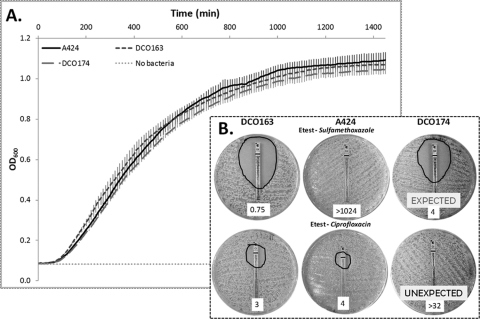Fig 4.
Growth curve and Etest analyses of Acinetobacter baumannii A424 and its TnAbaR23-minus mutants. (A) The wild-type strain A424 and DCO163 and DCO174 mutants were grown in 200 μl antibiotic-free LB medium at 37°C with shaking in 96-well plates from standardized overnight cultures and monitored in a Multiskan GO instrument to determine the optical density at 600 nm (OD600) measurements at 10-min intervals. The data shown represent the mean values ± standard deviations (error bars) for four independent wells for each strain. No significant difference in growth dynamics of the strains was observed. (B) Images of Etest assays for sulfamethoxazole and ciprofloxacin MICs on A424, DCO163, and DCO174 to highlight both an expected and an unexpected resistance phenotype of DCO174 associated with the loss of TnAbaR23. The edges of the zones of inhibition have been outlined, and the measured MIC values (in micrograms per milliliter) are shown on the white labels at the bottom of the plate image. The switch to sulfamethoxazole susceptibility observed in both DCO163 and DCO174 was entirely predictable from the defined gene content of TnAbaR23 and the PCR-informed absence of a sul1 gene elsewhere on the A424 chromosome. In contrast, the paradoxical changes in ciprofloxacin MIC values observed in DCO163 and DCO174 relative to that of A424 were entirely unexpected.

